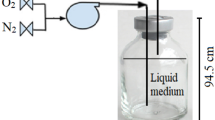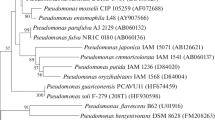Abstract
2,4-Dichlorophenoxyacetate (2,4-D) in Alcaligenes eutrophus JMP134 (pJP4) is degraded via 2-chloromaleylacetate as an intermediate. The latter compound was found to be reduced by NADH in a maleylacetate reductase catalyzed reaction. Maleylacetate and chloride were formed as products of 2-chloromaleylacetate reduction, the former being funnelled into the 3-oxoadipate pathway by a second reductive step. There was no indication for an involvement of a pJP4-encoded enzyme in either the reduction or the dechlorination reaction.
Similar content being viewed by others
Abbreviations
- 2,4-D:
-
2,4-dichlorophenoxyacetate
References
Bollag J-M, Briggs GG, Dawson JE, Alexander M (1968) 2,4-D Metabolism. Enzymatic degradation of chlorocatechols. J Agric Food Chem 16: 829–833
Bradford MM (1976) A rapid and sensitive method for the quantitation of microgram quantities of protein utilizing the principle of protein-dye binding. Anal Biochem 72: 248–254
Chapman PJ (1979) Degradation mechanisms. In: Bourquin AW, Pritchard PH (eds) Proceedings of the workshop: Microbial degradation of pollutants in marine environments. U.S. Environmental Protection Agency, Gulf Breeze, Florida, pp 28–66
Chapman PJ, Ribbons DW (1976) Metabolism of resorcinylic compounds by bacteria: Alternative pathways for resorcinol catabolism in Pseudomonas putida. J Bacteriol 125: 985–998
Chatterjee DK, Kellogg ST, Hamada S, Chakrabarty AM (1981) Plasmid specifying total degradation of 3-chlorobenzoate by a modified ortho pathway. J Bacteriol 146: 639–646
Chaudhry GR, Chapalamadugu S (1991) Biodegradation of halogenated organic compounds. Microbiol Rev 55: 59–79
Don RH, Weightman AJ, Knackmuss H-J, Timmis KN (1985) Transposon mutagenesis and cloning analysis of the pathways for degradation of 2,4-dichlorophenoxyacetic acid and 3-chlorobenzoate in Alcaligenes eutrophus JMP134 (pJP4). J Bacteriol 161: 85–90
Dorn E, Knackmuss H-J (1978) Chemical structure and biodegradability of halogenated aromatic compounds. Substituent effects on 1,2-dioxygenation of catechol. Biochem J 174: 85–94
Dorn E, Hellwig M, Reineke W, Knackmuss H-J (1974) Isolation and characterization of a 3-chlorobenzoate degrading pseudomonad. Arch Microbiol 99: 61–70
Duxbury JM, Tiedje JM, Alexander M, Dawson JE (1970) 2,4-D metabolism: Enzymatic conversion of chloromaleylacetic acid to succinic acid. J Agric Food Chem 18: 199–201
Engesser KH, Fischer P (1991) Degradation of haloaromatic compounds. In: Betts WB (ed) Biodegradation: natural and synthetic materials. Springer, Berlin Heidelberg New York, pp 15–54
Evans WC, Smith BSW, Moss P, Fernley HN (1971a) Bacterial metabolism of 4-chlorophenoxyacetate. Biochem J 122: 509–517
Evans WC, Smith BSW, Fernley HN, Davies JI (1971b) Bacterial metabolism of 2,4-dichlorophenoxyacetate. Biochem J 122: 543–551
Friedrich B, Meyer M, Schlegel HG (1983) Transfer and expression of the herbicide-degrading plasmid pJP4 in aerobic autotrophic bacteria. Arch Microbiol 134: 92–97
Gorlatov SN, Maltseva OV, Shevchenko VI, Golovleva LA (1989) Degradation of chlorophenols by a culture of Rhodococcus erythropolis. Mikrobiologiya 58: 802–806; Microbiology 58: 647–651
Häggblom M (1990) Mechanisms of bacterial degradation and transformation of chlorinated monoaromatic compounds. J Basic Microbiol 30: 115–141
Haigler BE, Nishino SF, Spain JC (1988) Degradation of 1,2-dichlorobenzene by a Pseudomonas sp. Appl Environ Microbiol 54: 294–301
Hartmann J, Reineke W, Knackmuss H-J (1979) Metabolism of 3-chloro-, 4-chloro-, and 3,5-dichlorobenzoate by a pseudomonad. Appl Environ Microbiol 37: 421–428
Kaschabek SR (1990) Untersuchungen zur Dehalogenierung von Chloromaleylacetaten in Pseudomonas sp. Stamm B13. Diplomarbeit, Bergische Universität — Gesamthochschule Wuppertal
Kaschabek S, Reineke W (1992) Maleylacetate reductase of Pseudomonas sp. strain B13: Purification and function in the degradation of dichloroaromatic compounds. Bioengineering 8: 40, V217
Kuhm AE, Schlömann M, Knackmuss H-J, Pieper DH (1990) Purification and characterization of dichloromuconate cycloisomerase from Alcaligenes eutrophus JMP134. Biochem J 266: 877–883
Kukor JJ, Olsen RH, Siak J-S (1989) Recruitment of a chromosomally encoded maleylacetate reductase for degradation of 2,4-dichlorophenoxyacetic acid by plasmid pJP4. J Bacteriol 171: 3385–3390
Neilson AH (1990) The biodegradation of halogenated organic compounds. J Appl Bacteriol 69: 445–470
Pemberton JM, Corney B, Don RH (1979) Evolution and spread of pesticide degrading ability among soil micro-organisms. In: Timmis KN, Pühler A (eds) Plasmids of medical, environmental and commercial importance. Elsevier/North Holland Biomedical Press, Amsterdam, pp 287–299
Pieper DH, Reineke W, Engesser K-H, Knackmuss H-J (1988) Metabolism of 2,4-dichlorophenoxyacetic acid, 4-chloro-2-methylphenoxyacetic acid and 2-methylphenoxyacetic acid by Alcaligenes eutrophus JMP134. Arch Microbiol 150: 95–102
Pieper DH, Kuhm AE, Stadler-Fritzsche K, Fischer P, Knackmuss H-J (1991) Metabolization of 3,5-dichlorocatechol by Alcaligenes eutrophus JMP134. Arch Microbiol 156: 218–222
Reineke W (1984) Microbial degradation of halogenated aromatic compounds. In: Gibson DT (ed) Microbial degradation of organic compounds. Marcel Dekker, New York Basel, pp 319–360
Reineke W, Knackmuss H-J (1988) Microbial degradation of haloaromatics. Annu Rev Microbiol 42: 263–287
Sander P, Wittich R-M, Fortnagel P, Wilkes H, Francke W (1991) Degradation of 1,2,4-trichloro-and 1,2,4,5-tetrachlorobenzene by Pseudomonas strains. Appl Environ Microbiol 57: 1430–1440
Schindowski A, Wittich R-M, Fortnagel P (1991) Catabolism of 3,5-dichlorosalicylate by Pseudomonas species strain JWS. FEMS Microbiol Lett 84: 63–70
Schlömann M, Pieper DH, Knackmuss H-J (1990a) Enzymes of haloaromatics degradation: variations of Alcaligenes on a theme by Pseudomonas. In: Silver S, Chakrabarty AM, Iglewski B Kaplan S (eds) Pseudomonas. Biotransformations, pathogenesis, and evolving biotechnology. American Society for Microbiology, Washington DC, pp 185–196
Schlömann M, Schmidt E, Knackmuss H-J (1990b) Different types of dienelactone hydrolase in 4-fluorobenzoate-utilizing bacteria. J Bacteriol 172: 5112–5118
Schlömann M, Fischer P, Schmidt E, Knackmuss H-J (1990c) Enzymatic formation, stability, and spontaneous reactions of 4-fluoromuconolactone, a metabolite of the bacterial degradation of 4-fluorobenzoate. J Bacteriol 172: 5119–5129
Schmidt E, Knackmuss H-J (1980) Chemical structure and biodegradability of halogenated aromatic compounds. Conversion of chlorinated muconic acids into maleoylacetic acid. Biochem J 192: 339–347
Schwien U, Schmidt E, Knackmuss H-J, Reineke W (1988) Degradation of chlorosubstituted aromatic compounds by Pseudomonas sp. strain B13: fate of 3,5-dichlorocatechol. Arch Microbiol 150: 78–84
Spain JC, Nishino SF (1987) Degradation of 1,4-dichlorobenzene by a Pseudomonas sp. Appl Environ Microbiol 53: 1010–1019
Tiedje JM, Duxbury JM, Alexander M, Dawson JE (1969) 2,4-D metabolism: pathway of degradation of chlorocatechols by Arthrobacter sp. J Agric Food Chem 17: 1021–1026
Van derMeer JR, vanNeerven ARW, deVries EJ, deVos WM, Zehnder AJB (1991a) Cloning and characterization of plasmidencoded genes for the degradation of 1,2-dichloro-, 1,4-dichloro-, and 1,2,4-trichlorobenzene of Pseudomonas sp. strain P51. J Bacteriol 173: 6–15
Van derMeer JR, Eggen RIL, Zehnder AJB, deVos WM (1991b) Sequence analysis of the Pseudomonas sp. strain P51 tcb gene cluster, which encodes metabolism of chlorinated catechols: Evidence for specialization of catechol 1,2-dioxygenases for chlorinated substrates. J Bacteriol 173: 2425–2434
Vollmer M, Schlömann M (1992) Enzymology of chloride elimination from chloromaleylacetate by Alcaligenes eutrophus JMP 134. Bioengineering 8: 64, P318
Author information
Authors and Affiliations
Rights and permissions
About this article
Cite this article
Vollmer, M.D., Stadler-Fritzsche, K. & Schlömann, M. Conversion of 2-chloromaleylacetate in Alcaligenes eutrophus JMP134. Arch. Microbiol. 159, 182–188 (1993). https://doi.org/10.1007/BF00250280
Received:
Accepted:
Issue Date:
DOI: https://doi.org/10.1007/BF00250280




